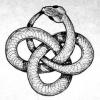Sorry I haven't been around for a while but I've been very busy. However this article today caught my attention. If this research is validated then perhaps we should re-examine the theories around the idea of a biological clock. However, seeing the life cycle in phases is not mutually exclusive to the basic idea of senescence due to cumulative mutation.
What this research does do is link back to Dawkin's selfish gene in the sense that when we cease to be fecund we also seem to accelerate the aging process and initiate at some point the "death spiral". More research is needed to integrate the various theories of aging.
https://www.yahoo.co...178.html?ref=gs

Biologists separate life into three phases: development, aging and late life. But a growing body of research now suggests that there is a fourth phase immediately preceding death that scientists have dubbed the "death spiral."
Although most of the "death spiral" research has focused on fruit flies, scientists think these studies can offer valuable insight into the last stage of human life as well.
"We believe this is part of the process of, basically, genetically programmed death," Laurence Mueller, chair of the Department of Ecology and Evolutionary Biology at the University of California, Irvine, said in an interview with Live Science. [What Are Your Odds of Dying From …]
Expiring fruit fliesOver the past decade, several studies of fruit flies have suggested this spiral toward death can be seen in the drop in reproductive rate (fecundity), according to a review of this research by Mueller and his colleagues, published earlier this year in the journal Biogerontology. For instance, researchers reporting in 2015 in The Journals of Gerontologyfound that the first day a female fly laid zero eggs was a significant predictor of death: Indicators of fecundity started to decline about 10 days before young female fruit flies laid zero eggs. The researchers think that whatever leads to the flies' deaths also affects their ability to reproduce in their final days.
In the new review, Mueller said that the timing of this decline matches another previous estimate of the death spiral's duration. Relative to the average life span of a fruit fly, 10 days could be as much as a third of a fly's life, Mueller said. Research from 2002 on Mediterranean fruit flies, called medflies, found that 97 percent of males began lying upside down about 16 days prior to death. In relative terms, this potential indicator of a death spiral is also approximately equal to the timing of the fecundity decline in the fruit flies. [The Science of Death: 10 Tales from the Crypt & Beyond]
In another study, scientists observed fruit flies, nematodes and zebrafish, to see if their intestines exhibited increased leakiness before death. The researchers tested this leakiness, called permeability, by feeding food dye to each animal. If permeability increased, that dye would leak out into the animal's body, and its body would change color — blue in the flies and fish, and fluorescent green in the nematodes. The research, published online March 22 in the journal Scientific Reports, concluded that this intestinal leakiness was a marker of death in all three species.
A human death spiral?The hope is that death-spiral research in fruit flies and other organisms could someday tell scientists more about the decline of humans prior to death. [8 Tips for Healthy Aging]
In their review paper, Mueller and his colleagues cited a study from 2008 published in the journal Proceedings of the National Academy of Sciencesas evidence that people may experience the death spiral as well. In that study, researchers analyzed data collected on the physical and cognitive abilities of 2,262 Danish people, ages 92 to 100, from 1998 to 2005. They found that the physical and cognitive scores of individuals who died within the first two years of the study were significantly lower than the scores of those who were still alive in 2005. The assessments included measures of grip strength, ability to complete daily activities (such as using the toilet and eating) and exams that helped evaluate cognitive impairment.
Basically, Mueller said, a death spiral in people could be the reason we often see a distinct increase in disability just before a person dies. Humans are challenging study subjects for both ethical and biological reasons, but looking at the death spiral in other organisms could give scientists a window into how this works in humans, the researchers said.
According to Mueller, the next step in this research might be to selectively breed the flies to create groups that experience death spirals of different durations.
"Once you create populations that are genetically different in that way, you can ask, 'What genes were changed in order to reduce the length of the death spiral?'" Mueller said. Using that knowledge, researchers could look at the human genome for similar genetic markers; humans are genetically similar to fruit flies, Mueller noted. According to yourgenome.com, a website of the Wellcome Genome Campus, 75 percent of disease-causing genes in humans are also present in fruit flies.
Mueller said the research isn't about stopping or even delaying death. Rather, he sees it as a way to improve people's quality of life when they are reaching the end and potentially save immense amounts of money in end-of-life health care.
"Even if we don't affect when you die, we'd like to make you fully functional up to the day you die," he said.
Original article on Live Science.
Editor's Recommendations




















































